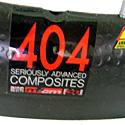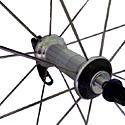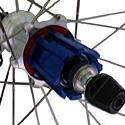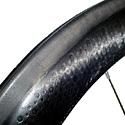
Recently on Cyclingnews.com |
On test: Zipp 404 wheels, November 5, 2005
When aerodynamics count
Zipp has been an innovator in the composite wheel sector for over 15 years, and is constantly refining its products to make them lighter, more aerodynamic, and faster. Cyclingnews' Chief Online Editor Jeff Jones took a pair of Zipp 404s for an extended spin, and discovered that there is more to wheel aerodynamics than a triangular rim cross-section.
History

|
Zipp started life in 1988 after Leigh Sargent, a racing car composites and aerodynamic specialist, realised that there was a gap in the cycling industry to market composite disc wheels. Starting with 1150g and 1350g discs, Zipp grew over the years, putting its wheels under Hawaii Ironman and World ITU winners, Olympic gold medalists, world track champions, and Tour de France podium finishers. During this time, its wheels have developed into some of the lightest and most aerodynamic out there, with carbon fibre being the main material used.
Zipp has always been popular with the triathlon world, but it has been active in the sponsorship of pro road teams as well. Team CSC has been riding Zipps since 2003 - a choice that surely wasn't based just on colour coordination - while Phonak came on board in 2004. Zipp is now involved more than ever in the pure road market.
Zipp 404 specifications
The 404 is a deep section carbon wheel designed primarily for road racing, although it can also obviously be used for time trialling and criteriums without disadvantage. The rims we tested were tubulars, which have the benefit of light weight (1276g a pair), a slightly smoother ride when combined with a good quality single, but generally require more maintenance from punctures. The 404 is available in clincher (1680g), Clydesdale (1390/1775), Cyclo-cross (1470g), Track (1800g - higher spoke count and high flange hubs) and a special Z4 tubular (1268g).
The rims are made purely from carbon fibre, the majority of which is "uni-directional", as opposed to "woven" fibre. Building anything out of uni-directional carbon fibres requires a great deal of care in the design, as the fibre will work most effectively when loaded on its axis. But the advantage is in saving weight, as this type of design maximises strength and stiffness for a minimal use of material. Zipp uses woven fibers in spoke-hole areas and damage prone areas to increase robustness. The braking and tyre mounting surfaces are reinforced by a woven silica/ceramic fabric and woven carbon fabric, which enables the rim to handle the stronger compression forces and wear in those areas.
Zipp has remained with metal for its spokes, 18 of which are used for the front and 24 for the rear. The spokes are ovalised, which are faster in all conditions than a round spoke, and faster in crosswinds than bladed spokes. Zipp also uses straight pull spokes to reduce the frequency of spoke breakages. Straight-pull spokes take advantage of the axial loading afforded by Zipp's rim and hub design. The disadvantage of this is that the hubs are a bit trickier to design and build, but Zipp has taken this in its stride.
Speaking of hubs, these are another part of the 404 that don't use any carbon fibre. They are made from Alcoa 7075 aluminum with Swiss ultra-precision steel bearings that are round to within 10 millionths of an inch. Zipp is quite proud of its bearings, claiming them to be at least 2.5 times rounder than a Campagnolo Record bearing. The bearings are housed in a teflon bearing locator, as opposed to a brass one, and Zipp uses its own hydro-carbon grease to reduce friction as much as possible. The net result is a hub that spins more smoothly, giving a 1 Watt saving at 30 mph (48 km/h) compared to a stock hub.
The axle is 15mm diameter, oversized to contribute to stiffness, but the weight has been kept down. In 2006, the Zipp hub's ratchets and pawls will be machined using a wire EDM, which enables them to be hardened and weight reduced. That means next year's hubs will weigh 176 grams for a Campagnolo and 182 grams for a Shimano and 82 grams for a front. This year's hubs (which I am using) are around 210 grams for a Campagnolo, 217 grams for a Shimano, and 90 grams for a front. Our set of Zipps came with a Campagnolo compatible cassette body.
Zipp supplied us with a set of tubulars to go with the 404s, which have been specifically designed to match the Zipp rims, maximising the aerodynamic benefits. The tyres are 300 tpi (threads per inch) and weigh 250 grams each for a 700x21c model. The wheels also came with a set of Zipp brake pads, which I didn't end up using after I lost one, then found I didn't have Campagnolo cartridge brake shoes, and the ones sold to me by my bike shop were not, in fact, Campag compatible. So I ended up with BBB carbon pads, which seemed to work fine in the wet and dry.
Finally, the cost of a pair of Zipp 404s is US$1750. That's towards the upper end of the scale when it comes to buying wheels, but quite similar to the other carbon wheelsets out there. Apart from Lightweights, which are off the scale.
Aerodynamics
Zipp is very big on aerodynamics. And so it should be, given the importance of aerodynamics in determining the speed of riding a bicycle. Wheels are of particular interest, as they are rotating as well as moving laterally through the air. That means that at the top of its revolution, the edge of the wheel is travelling twice as fast through the air as the rest of the bike. Thus, special attention should be paid to wheel and rim design if the aim is to maximise speed. Zipp has done a lot of wind tunnel testing during its product development phase, rather than after it, with obvious benefits.
The Zipp 404 rim is 58mm deep and 20mm wide. This cuts spoke length by around 40mm compared to a normal rim, and therefore eliminates the end of the spoke that results in the most wheel drag. Zipp estimates that a rim has to be at least 38mm to provide a significant aero benefit over a normal rim.
Bicycle road wheels also have to perform in crosswinds, and this is one area where deep section rims usually fail. There's nothing more annoying and dangerous than riding an aero rim or a disc in a strong crosswind, and you usually find that a lot of your concentration is devoted to keeping the bike in a straight line, rather than considering your next move in a race. Zipp has tried to minimise the load on its wheels in crosswinds by flaring the rim outwards below the braking surface. The aim is to "recapture" turbulent flow around the tyre/rim interface, reducing the drag on the whole rim. Zipp claims its wheels perform best in crosswinds of any wheel of a comparative depth.
A relatively new feature of the Zipps is a dimpled rim surface, which the company claims improves aerodynamics and handling. Think golf balls and other rough surfaced objects (tennis balls, aircraft wings, racing cars), which try to eliminate drag by increasing turbulence at the surface. The 404s have this dimpled pattern, said to provide a power saving of between 1 and 4 Watts, depending on conditions.
What it all boils down to is not exactly a single number, e.g. a kilometre per hour or a Wattage figure that you will save by riding Zipps compared to normal box section, spoked wheels. This will depend on the angle and strength of the wind, the speed of the bike, how aero the rider is in the first place, and so on. But it's still good to know, so I asked Zipp's number one wheel guy Josh Poertner what he could give me.
Given a power output of 300 Watts, a wind angle of 15 degrees of yaw, the Zipp 404 will require 4 Watts less power than a Mavic Ksyrium to spin. This is added to the drag saving of 16 Watts (0.26lbs of drag) for a 20 Watt saving, or roughly 82 seconds over 40 km in these (unrealistically) static conditions. When comparing to a GL330 (round spoked, box section wheel), a Zipp 404 will save you about an extra 15 Watts on top of a Ksyrium, which will end up as approximately 140 seconds over 40 km.
The above assumes a number of things, and if the rider and bike are very aero to start with, then the time savings will be less, as the average speed will be higher. But it's still good to know.
On the road
Right, enough science. How do these babies roll, and are they as fast as they claim to be?
Tubulars are not my favourite wheels to train on, because I tend to puncture more often on them than on clinchers. Nevertheless, I was able to get in a bit of quality time outside racing with just me, the Zipp 404s and the road. Until my third puncture, which is when I switched to using them for racing only.
The first thing I noticed about the 404s compared to other deep-rimmed wheels that I've ridden on was their handling in crosswinds. Without a doubt for me, these are the most stable wheels of this type that I've had the pleasure of riding. I took them out solo and in group rides where I often encountered strong crosswinds, and they were only slightly more difficult to control than a standard wheelset. By slightly, I mean that I had no qualms about using the front and the back on very windy days. With other deep-section wheels, I've often replaced the front with a Ksyrium or something similar when the flags were flying.
The next thing I noticed was how comfortable they were to ride on. I have a fairly unforgiving aluminium frame, and combined with Ksyriums, it doesn't exactly give the softest ride. The Zipp 404s were better at soaking up the "road variations" that I encountered at frequent intervals. I didn't thrash them over too many cobbles, but they got their share of rough roads, and they made things a good deal more pleasant.
Speed-wise, I expected the 404s to be quick and I wasn't disappointed. Like any good deep profile wheels, the Zipp 404s perform best at high speeds - 40 km/h or more. They were incredible on descents, and they would carry me down any hill faster than anyone else. Without pedaling, I would just find myself rolling past everyone I was riding with. On the flat, they offer excellent acceleration and the ability to maintain a high speed. They were perfect for practically all types of racing situations: either constant speed time trialing, hilly, flat, or windy road racing, and stop-start criterium racing. The only races I would be reluctant to use the 404s would be ones that were heavily dosed with cobbles.
In a real life situation, I used the Zipp 404s at the Journalists' World Championships in San Marino on a very hilly course. I definitely appreciated their lightness and aerodynamics. I wasn't quite good enough to win on that day, but a second place wasn't too bad, and I definitely couldn't blame my wheels for not winning.
I found the Zipps to be stiff enough for racing, but not super-stiff. Their moderate spoke count (24 rear/18 front) helps to reduce lateral flexing, as there's nothing worse than a wheel that rubs on the brake pads when you put the power down. The 404s flexed a bit, as all carbon wheels tend to do, but loosening the brakes by a few millimetres was sufficient to cope with that.
In the rain, which is the bane of most carbon wheels, the Zipps performed better than expected. While not as good as machined alloy, the woven silica/ceramic fabric braking surface was good enough to slow you down properly without being too grippy.
The one slightly annoying thing I experienced with my set of wheels was that the front was slightly out of true, which was immediately noticeable while braking. I attempted to true it myself, which improved things, but I could never get it perfect. Truing wheels with bladed spokes is definitely not my forte. The rear wheel was perfectly in true, and stayed that way throughout the test with no braking issues.
Wear
I put a couple of thousand kilometres on the wheels during the test, and they held up just fine, as one would hope. But, as mentioned above, I was wary of taking them on too many cobbled roads. There's something about carbon and cobbles that makes me uneasy. I did find out from Team CSC, who were using the 404s and 303s, that they broke something like 20 rims during the spring classics, including eight in the Tour of Flanders alone. I contacted Zipp about this, and they confirmed the breakage rate, but also put it into perspective.
Pro riders are incredibly hard on equipment, far more than an amateur hack like me, and CSC actually broke half as many rims as normal during their spring campaign. This is not only due to the faster speeds, rougher roads and more stressful conditions in most pro races, but also the number of crashes. Zipp's tech expert Josh Poertner explained that most of their wheel breakages were as a result of crashes, not failures. "In fact, the only catastrophic type failure we are aware of was a rim that had previously been damaged in an accident where the mechanics had filled the crack with a mixture of epoxy and carbon shavings," said Poertner. "This technique is somewhat common in minor frame repair which is where the mechanics learned it, but the result was a crack in the rim that continued to grow under the epoxy filler until the rim basically folded in that area."
Poertner added that because of the ProTour induced need to run an extra truck, the team was using wheels that were saved from the previous year, including some spring classics and Tour de France wheels that had done over 10,000 km of racing. "The data we have from the team shows that many of the problems we had this year were simply related to product that was worn out and meant to be retired, plus we have made three laminate/material changes in the last 16 months adding roughly 15% additional strength to the wheels, so there are other advantages to having new wheels than them just being new," he explained.
Unlike most other wheels ridden by pros, the Zipps ridden by CSC and Phonak are identical to those available to the general public, i.e. the pros don't get any extra laminates or materials, or special quality control. "We really feel that every product going out the door is a pro calibre product, so there is no need to discriminate between them," said Poertner.
How does all this scale for the average consumer? "As with any manufactured product, there will be some rims made with problems, but our yearly warranty rate combined with crash replacement (our low cost no-fault replacement program) runs at less than 1 percent of production," Poertner pointed out, explaining that if a design fault is found, it can be easily rectified within a couple of days.
The bottom line? If the wheels are abused or crashed, they will eventually break. But the same goes for any wheels, particularly carbon wheels. Zipp acknowledges this, but at the same time points out that their rate of failure is much lower than many of the other wheels used by professional teams, in particular.
Overall
Considering all the criteria for a perfect set of racing wheels, the Zipp 404s come very, very close to meeting them. They are very aerodynamic for a rim of this depth, quite light at under 1300 grams/pair, and comfortable to ride on. I found them to handle remarkably well in crosswinds as well, which I can't say for most deep-sectioned wheels I've tried. As for durability, I'd recommend using them for racing on smooth roads and to avoid crashing!
Also see: Zipp to roll out fast new wheel for Tour prologue (June 29, 2004)
Recommended retail price: US$1750.00
Claimed weight: 1276g pair
Colour: Black rim, silver spokes/hubs
Rims: Carbon fibre (38mm x 58mm)
Spokes: Steel, bladed
Hub shell: Alcoa Aluminium 7075
Hub body: Alcoa Aluminium 7075
Axles: Alcoa Aluminium 7075
Pro: Aerodynamic, fast, light, excellent handling, comfortable
Con: Not the best for rough roads
More information: Zipp's
website
Cyclingnews Rating: ![]()









